Etiqueta "programación"
Se han encontrado 75 Coincidencias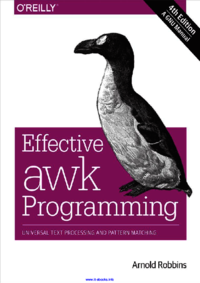
Effective awk Programming: Universal Text Processing and Pattern Matching
AWK
85 Visitas | 99 Descargas | 2015-03-10 22:21:52 | cbustillo
When processing text files, the awk language is ideal for handling data extraction, reporting, and data-reformatting jobs. This practical guide serves as both a reference and tutorial for POSIX-standard awk and for the GNU implementation, called gawk. This book is useful for novices and awk experts alike. In this thoroughly revised edition, author and gawk lead developer Arnold Robbins describes the awk language and gawk program in detail, shows you how to use awk and gawk for problem solving, and then dives into specific features of gawk. System administrators, programmers, webmasters, and other power users will find everything they need to know about awk and gawk.
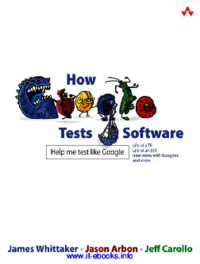
How Google Tests Software
pruebas de software
96 Visitas | 104 Descargas | 2015-03-20 13:24:16 | javierd
Software development is hard. Testing that software is hard, too. And when you talk about development and testing at the scale of the entire web, you are talking about Google. If you are interested in how one of the biggest names in the Internet handles such large-scale testing, then you have found the right book. Google tests and releases hundreds of millions of lines of code distributed across millions of source files daily. Billions of build actions prompt millions of automated tests to run across hundreds of thousands of browser instances daily. Operating systems are built, tested, and released within the bounds of a single calendar year. Browsers are built daily. Web applications are released at near continuous pace. In 2011, 100 features of Google+ were released over a 100-day period.
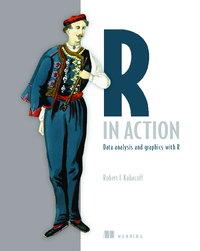
R in Action
Programación en R
104 Visitas | 107 Descargas | 2015-04-30 14:50:46 | josedanielr
R in Action provides you with a guided introduction to R, giving you a 2,000-foot view of the platform and its capabilities. It will introduce you to the most important functions in the base installation and more than 90 of the most useful contributed packages. Throughout the book, the goal is practical application—how you can make sense of your data and communicate that understanding to others. When you finish, you should have a good grasp of how R works and what it can do, and where you can go to learn more. You’ll be able to apply a variety of techniques for visualizing data, and you’ll have the skills to tackle both basic and advanced data analytic problems.
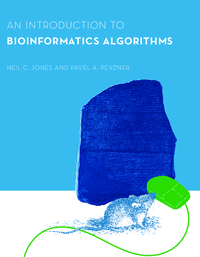
An Introduction to Bioinformatics Algorithms
83 Visitas | 125 Descargas | 2015-07-17 18:21:43 | alejandromorales
This is an introductory textbook on bioinformatics algorithms and the com- putational ideas that have driven them through the last twenty years. There are many important probabilistic and statistical techniques that we do not cover, nor do we cover many important research questions that bioinfor- maticians are currently trying to answer. We deliberately do not cover all areas of computational biology; for example, important topics like protein folding are not even discussed.
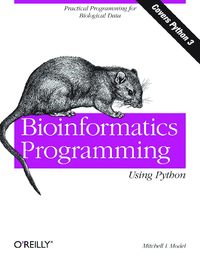
Bioinformatic programming with Python
Programación en el área de bioinformática utilizando Python como lenguaje de Programación
91 Visitas | 134 Descargas | 2015-07-17 18:16:31 | alejandromorales
The purpose of this book is to show the reader how to use the Python programming language to facilitate and automate the wide variety of data manipulation tasks encountered in life science research and development. It is designed to be accessible to readers with a range of interests and backgrounds, both scientific and technical. It emphasizes practical programming, using meaningful examples of useful code. In addition to meeting the needs of individual readers, it can also be used as a textbook for a one-semester upper-level undergraduate or graduate-level course. This book is designed to teach you bioinformatics software development. There is no computational biology here: no statistics, formulas, equations—not even explanations of the algorithms that underlie commonly used informatics software. The book’s examples are all based on the kind of data life science researchers work with and what they do with it. The book focuses on practical data management and manipulation tasks. The term “data” has a wide scope here, including not only the contents of databases but also the contents of text files, web pages, and other information sources. Examples focus on genomics, an area that, relative to others, is more mature and easier to introduce to people new to the scientific content of bioinformatics, as well as dealing with data that is more amenable to representation and manipulation in software. Also, and not incidentally, it is the part of bioinformatics with which the author is most familiar.
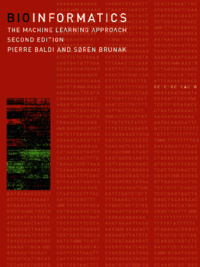
Bioinformatics: The machine Learning Approach
107 Visitas | 133 Descargas | 2015-07-17 18:27:24 | alejandromorales
The book is aimed at both students and more advanced researchers, with diverse backgrounds. We have tried to provide a succinct description of the main biological concepts and problems for the readers with a stronger background in mathematics, statistics, and computer science. Likewise, the book is tailored to the biologists and biochemists who will often know more about the biological problems than the text explains, but need some help to understand the new data-driven algorithms, in the context of biological data. It should in principle provide enough insights while remaining sufficiently simple for the reader to be able to implement the algorithms described, or adapt them to a particular problem. The book, however, does not cover the informatics needed for the management of large databases and sequencing projects, or the processing of raw fluorescence data. The technical prerequisites for the book are basic calculus, algebra, and discrete probability theory, at the level of an undergraduate course. Any prior knowledge of DNA, RNA, and proteins is of course helpful, but not required.
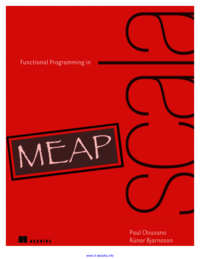
Functional Programming in Scala
Functional Programming in Scala MEAP
70 Visitas | 99 Descargas | 2015-11-02 15:34:17 | pecarrazana
This book introduces the concepts and techniques of functional programming (FP)—we use Scala as the vehicle, but the lessons here in can be applied to programming in any language. Our goal is to give you the foundations to begin writing substantive functional programs and to comfortably absorb new FP concepts and techniques beyond those covered here. Throughout the book we rely heavily on programming exercises, carefully chosen and sequenced to guide you to discover FP for yourself. Expository text is often just enough to lead you to the next exercise. Do these exercises and you will learn the material. Read without doing and you will find yourself lost.
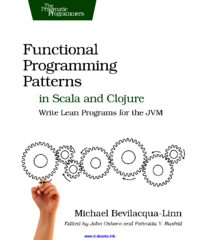
Functional Programming Patterns in Scala and Clojure
Functional Programming Patterns in Scala and Clojure
73 Visitas | 82 Descargas | 2015-11-02 15:38:56 | pecarrazana
This book is about patterns and functional programming in Scala and Clojure. It shows how to replace, or greatly simplify, many of the common patterns we use in object-oriented programming, and it introduces some patterns commonly used in the functional world. Used together, these patterns let programmers solve problems faster and in a more concise, declarative style than with object-oriented programming alone. If you’re using Java and want to see how functional programming can help you work more efficiently, or if you’ve started using Scala and Clojure and can’t quite wrap your head around functional problem-solving, this is the book for you.
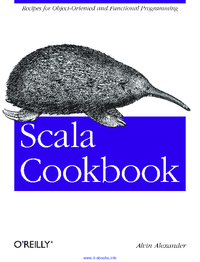
Scala Cookbook
Scala Cookbook
135 Visitas | 87 Descargas | 2015-11-02 15:41:21 | pecarrazana
This is a cookbook of problem-solving recipes about Scala, the most interesting programming language I’ve ever used. The book contains solutions to more than 250 common problems, shown with possibly more than 700 examples. (I haven’t counted, but I suspect that’s true.) There are a few unique things about this book: • As a cookbook, it’s intended to save you time by providing solutions to the most common problems you’ll encounter. • Almost all of the examples are shown in the Scala interpreter. As a result, whether you’re sitting by a computer, on a plane, or reading in your favorite recliner, you get the benefit of seeing their exact output. (Which often leads to, “Ah, so that’s howthat works.”) • The book covers not only the Scala language, but also has large chapters on Scalatools and libraries, including SBT, actors, the collections library (more than 100pages), and JSON processing. Just prior to its release, the book was updated to cover Scala 2.10.x and SBT 0.12.3.
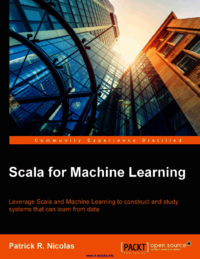
Scala for Machine Learning
Scala for Machine Learning
85 Visitas | 99 Descargas | 2015-11-02 15:43:18 | pecarrazana
Not a single day passes by that we do not hear about Big Data in the news media, technical conferences, and even coffee shops. The ever-increasing amount of data collected in process monitoring, research, or simple human behavior becomes valuable only if you extract knowledge from it. Machine learning is the essential tool to mine data for gold (knowledge). This book covers the "what", "why", and "how" of machine learning: • What are the objectives and the mathematical foundation of machine learning? • Why is Scala the ideal programming language to implement machine learning algorithms? • How can you apply machine learning to solve real-world problems? Throughout this book, machine learning algorithms are described with diagrams, mathematical formulation, and documented snippets of Scala code, allowing you to understand these key concepts in your own unique way.
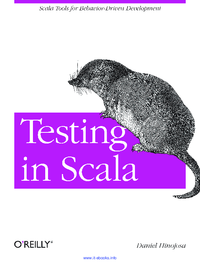
Testing in Scala
70 Visitas | 88 Descargas | 2015-11-02 15:47:56 | pecarrazana
This book enhances the Scala language with standard test-driven development practices, highlighting the best testing tools today. This book will cover both the ScalaTest and the Specs2 testing frameworks, which help you create quick and easy tests. Testing is also often the most overlooked aspect of introductory programming language books. This book is dedicated to mending that gap.We will run all these tests using Simple Build Tool (SBT). SBT is similar to some earlier build tools and competitors: Maven, Gradle, and Buildr. What makes SBT highly attractive is its ease of use and the small size of the build file. Type a few lines of code for your build file and you’re off and running on your project. We will also cover SBT’s wonderful triggered execution feature, which complements test-driven development by building and testing code whenever a file is saved.ScalaTest and Specs2 are two of the most dominant testing frameworks for Scala around today. Each framework has a different intent and goal, but they share the some ideal of making testing concise, and they both leverage the Scala programming language to make testing easy and fun. Testing frameworks are nothing new, of course, and have been used with other programming languages for years. Those familiar with other programming languages and their testing tools will find some similarities with Scala’s current testing tools. ScalaTest and Specs2 borrowed ideas from Cucumber. But upon these shoulders of giants, Scala testing systems have also stepped out on their own and created some of the most mind-blowing testing tools found in any language. Testing in Scala will also illustrate mocking code, so as to keep our tests isolated from large subsystems and networks. Mocking is, in essence, creating a substitute for various objects to isolate tests from volatile elements of their environment (such as the contents of databases) and to help unit tests run fast. This book shows how you can use Scala with Java-based mocking frameworks that have been used for years by Java programmers, EasyMock and Mockito. We will also introduce you to a new framework, ScalaMock. Formerly known as Borachio, ScalaMock was inspired by Java’s EasyMock and Mockito but takes their work further, even offering support for mocking final classes and Scala objects.
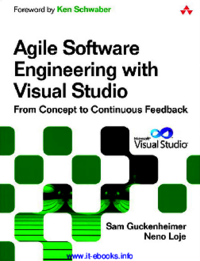
Agile Software Engineering with Visual Studio
Agile Software Engineering with Visual Studio
111 Visitas | 137 Descargas | 2015-11-02 16:02:23 | pecarrazana
Five years ago, we extended the world’s leading product for individual developers, Microsoft Visual Studio, into Visual Studio Team System, and it quickly became the world’s leading product for development teams. This addition of Application Lifecycle Management (ALM) to Visual Studio made life easier and more productive for hundreds of thousands of our users and tens of thousands of our Microsoft colleagues. In 2010, we shipped Visual Studio 2010 Premium, Ultimate, Test Professional, and Team Foundation Server. (We’ve dropped the Team System name.) We’ve learned a lot from our customers in the past five years. Visual Stu- dio 2010 is a huge release that enables a high-performance Agile software team to release higher-quality software more frequently. We set out to enable a broad set of scenarios for our customers. We systematically attacked major root causes of waste in the application lifecycle, elevated transparency for the broadly engaged team, and focused on flow of value for the end customer. We have eliminated unnecessary silos among roles, to focus on empowering a multidisciplinary, self-managing team. Here are some examples.
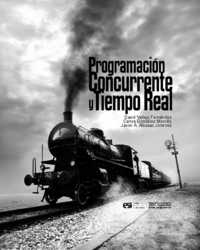
Programación Concurrente y Tiempo Real
159 Visitas | 212 Descargas | 2015-11-10 18:39:09 | osmanir
Este libro recoge los aspectos fundamentales, desde una perspec- tiva esencialmente práctica y en el ámbito de los sistemas operativos, de Programación Concurrente y de Tiempo Real, asignatura obligato- ria en el segundo curso del Grado en Ingeniería en Informática en la Escuela Superior de Informática (Universidad de Castilla-La Mancha). El principal objetivo que se pretende alcanzar es ofrecer al lector una visión general de las herramientas existentes para una adecuada pro- gramación de sistemas concurrentes y de los principales aspectos de la planificación de sistemas en tiempo real. La evolución de los sistemas operativos modernos y el hardware de procesamiento, esencialmente multi-núcleo, hace especialmente rele- vante la adquisición de competencias relativas a la programación con- currente y a la sincronización y comunicación entre procesos, para incrementar la productividad de las aplicaciones desarrolladas. En es- te contexto, el presente libro discute herramientas clásicas, como los semáforos y las colas de mensajes, y alternativas más flexibles, como los monitores o los objetos protegidos. Desde el punto de vista de la implementación se hace uso de la familia de estándares POSIX y de los lenguajes de programación C, C++ y Ada. Por otra parte, en este libro también se discuten los fundamentos de la planificación de sistemas en tiempo real con el objetivo de poner de manifiesto su importancia en el ámbito de los sistemas críticos. Conceptos como el tiempo de respuesta o el deadline de una tarea son esenciales para la programación de sistemas en tiempo real.
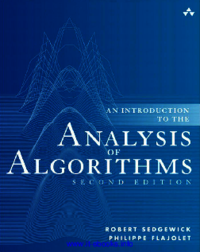
An Introduction to the Analysis of Algorithms
Análisis de algoritmos
139 Visitas | 185 Descargas | 2015-12-14 14:04:12 | josedaniel
This book is intended to be a thorough overview of the primary techniques used in the mathematical analysis of algorithms. The material covered draws from classical mathematical topics, including discrete mathematics, elementary real analysis, and combinatorics, as well as from classical computer science topics, including algorithms and data structures. The focus is on “average-case” or “probabilistic” analysis, though the basic mathematical tools required for “worst-case” or “complexity” analysis are covered as well.
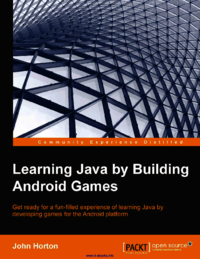
Learning Java by Building Android Games
Programación en Java para Android
157 Visitas | 191 Descargas | 2015-12-16 19:06:16 | josedaniel
This book will show you how to get your Android development environment set up and you will soon have your first working game. The difficulty level grows steadily with the introduction of key Java topics such as loops, methods, and OOP. You'll then use them in the development of games. You will learn how to build a math test game, a Simon-like memory game, a retro pong-style game, and for the grand finale, a Snake-style, retro arcade game with real Google Play leaderboards and achievements. The book has a hands-on approach and is packed with screenshots.
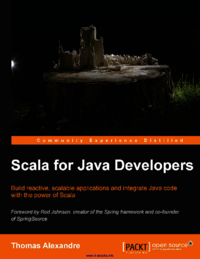
Scala for Java Developers
Programación en Scala
78 Visitas | 110 Descargas | 2016-01-05 19:49:08 | asielalonso
As a Java developer, you must have heard a lot about Scala, even if you haven't yet written any Scala code. You must have noticed that Scala is becoming popular and heard vigorous debate about it. As I sat down to write this, I typed "scala is" into Google. The top completions included "scala is awesome", "scala is too complex", and "scala is hard." Understandably, you may be confused by such polarization. You may also have heard arcane, possibly off-putting details about obscure Scala idioms and advanced functional programming. What you probably have not heard is a methodical, impartial attempt to answer questions such as "might Scala make me more productive in my daily work?", "will it be easy for me to pick up Scala?", and ultimately, "Should I switch from Java to Scala?".
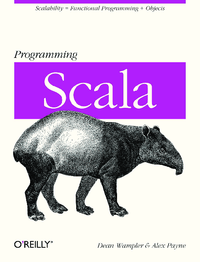
Programming Scala
Programación en Scala
69 Visitas | 91 Descargas | 2016-01-05 19:52:05 | asielalonso
When I discovered Scala some years ago, the thing that made the biggest impression on me was its composability. Through some very elegant design choices and simple yet powerful abstractions that were taken from the object-oriented and functional programming worlds, Martin Odersky has managed to create a language with high cohesion and orthogonal, deep abstractions that invites composability in all dimensions of software design. Scala is truly a SCAlable LAnguage that scales with usage, from scripting all the way up to large-scale enterprise applications and middleware. Scala was born out of academia, but it has grown into a pragmatic and practical language that is very much ready for real-world production use. You are about to learn how to write reusable components using mixin and function composition; how to write concurrent applications using Scala’s Actors; how to make effective use of Scala’s XML/XPath support; how to utilize Scala?s rich, flexible, and expressive syntax to build Domain-Specific Languages; how to effectively test your Scala code; how to use Scala with popular frameworks such as Spring, Hadoop, and Terracotta; and much, much more. Enjoy the ride. I sure did.
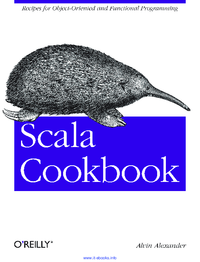
Scala Cookbook
Programación en Scala
84 Visitas | 117 Descargas | 2016-01-05 19:55:56 | asielalonso
Save time and trouble when using Scala to build object-oriented, functional, and concurrent applications. With more than 250 ready-to-use recipes and 700 code examples, this comprehensive cookbook covers the most common problems you'll encounter when using the Scala language, libraries, and tools. It's ideal not only for experienced Scala developers, but also for programmers learning to use this JVM language.
Contribuir
Usted puede contribuir con Libros UCLV, es importante para nosotros su aporte..
Contribuir